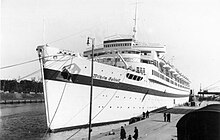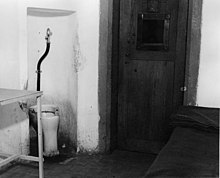Robert Ley
He volunteered for the army on the outbreak of World War I in 1914 and spent two years in the 10th Foot Artillery Regiment and saw action on both the eastern and western fronts.
Enraged by the French occupation of the Ruhr in 1924, Ley became an ultra-nationalist and joined the Nazi Party soon after reading Adolf Hitler's speech at his trial following the Beer Hall Putsch in Munich.
[8] At a meeting on 24 January 1926, however, Ley joined with others in raising objections to Strasser's proposed new draft program and it was shelved.
In March 1928, Ley became the editor and publisher of a virulently anti-Semitic Nazi newspaper, the Westdeutscher Beobachter (West German Observer) in Cologne.
On 10 May 1933, Hitler appointed Ley head of the newly founded German Labour Front (Deutsche Arbeitsfront, DAF).
The NSBO cells continued to agitate in the factories on issues of wages and conditions, annoying the employers, who soon complained to Hitler and other Nazi leaders that the DAF was as bad as the Communists had been.
[15] Hitler had no sympathy with the syndicalist tendencies of the NSBO, and in January 1934 a new Law for the Ordering of National Labour effectively suppressed independent working-class factory organisations, even Nazi ones, and put questions of wages and conditions in the hands of the Trustees of Labour (Treuhänder der Arbeit), dominated by the employers.
[18] By 1938 he owned a luxurious estate near Cologne, a string of villas in other cities, a fleet of cars, a private railway carriage and a large art collection.
In November 1933, as a means of preventing labour disaffection, the DAF established Strength Through Joy (Kraft durch Freude, KdF), to provide a range of benefits and amenities to the German working class and their families.
Two of the world's first purpose-built cruise-liners, the Wilhelm Gustloff and the Robert Ley, were built to take KdF members on Mediterranean cruises.
Other KdF programs included concerts, opera and other forms of entertainment in factories and other workplaces, free physical education and gymnastics training and coaching in sports such as football, tennis and sailing.
The DAF and KdF's most ambitious program was the "people's car," the Volkswagen, originally a project undertaken at Hitler's request by the car-maker Ferdinand Porsche.
Ley said in a speech in 1939: "We National Socialists have monopolized all resources and all our energies during the past seven years so as to be able to be equipped for the supreme effort of battle.
The militarisation of the workforce and the diversion of resources to the war greatly reduced the role of the DAF, and the KdF was largely curtailed.
Ley played some role in this program, but was overshadowed by Fritz Sauckel, General Plenipotentiary for the Distribution of Labour (Generalbevollmächtigter für den Arbeitseinsatz) since March 1942.
In this role he became a key ally of Armaments Minister Albert Speer, who recognised that German workers must be adequately housed if productivity was to be maintained.
In February 1941 he was present at a meeting along with Speer, Bormann and Field Marshal Wilhelm Keitel at which Hitler had set out his views on the "Jewish question" at some length, making it clear that he intended the "disappearance" of the Jews one way or another.
[23] According to American historian Jeffrey Herf, Ley issued some of the most overt propaganda accusing Jews of plotting the extermination of Germans and threatening to do the reverse.
[24] In April 1945, Ley became enamored with the idea of creating a "death ray" after receiving a letter from an unnamed inventor: "I've studied the documentation; there's no doubt about it.
The next day he left for southern Bavaria, in the expectation that Hitler would make his last stand in the "National Redoubt" in the alpine areas.
[27] Ley told them he was "Dr Ernst Distelmeyer," but he was identified by Franz Xaver Schwarz, the treasurer of the Nazi Party and a long-time enemy.
[29] Ley was apparently indignant at being regarded as a war criminal, telling the American psychiatrist Douglas Kelley[30] and psychologist Gustave Gilbert who had seen and tested him in prison: "Stand us against a wall and shoot us, well and good, you are victors.
[31] On 24 October, three days after receiving the indictment, Ley strangled himself to death in his prison cell using a noose made by tearing a towel into strips, fastened to the toilet pipe.






